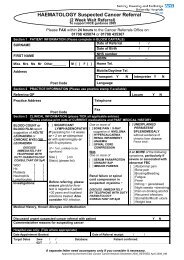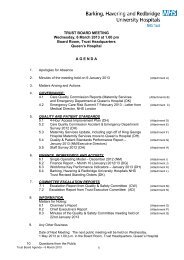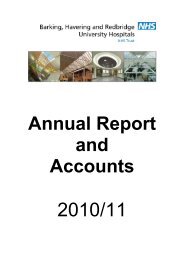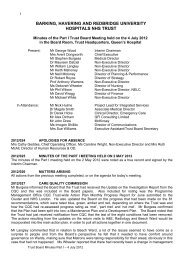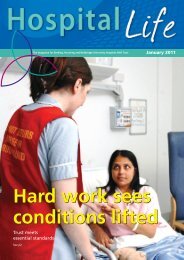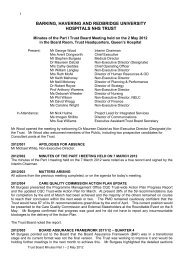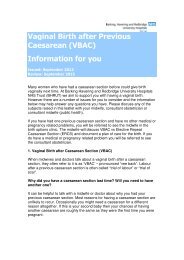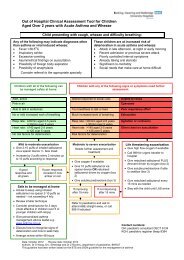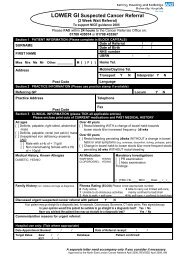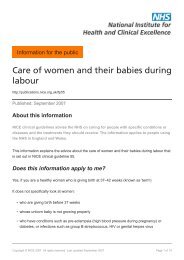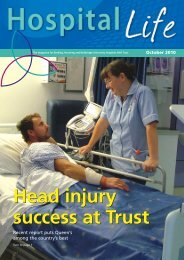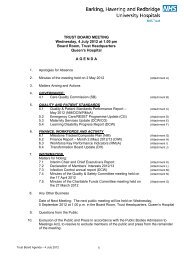Trust Board papers November 2012 - Barking Havering and ...
Trust Board papers November 2012 - Barking Havering and ...
Trust Board papers November 2012 - Barking Havering and ...
You also want an ePaper? Increase the reach of your titles
YUMPU automatically turns print PDFs into web optimized ePapers that Google loves.
Where there are actual or potential risks with high or extreme consequences <strong>and</strong>/or likelihood<br />
that require additional resources, the relevant Directorate will submit Risk assessment <strong>and</strong><br />
action plans for consideration by <strong>Trust</strong> Executive Leads <strong>and</strong> <strong>Trust</strong> <strong>Board</strong>.<br />
Monitor <strong>and</strong> Review<br />
Monitor <strong>and</strong> review the performance of the risk action plan, undertake assessment to identify<br />
gaps <strong>and</strong> improvement. Review your risk assessment <strong>and</strong> update if necessary<br />
Communicate <strong>and</strong> consult<br />
Communicate <strong>and</strong> consult any difficulties with the Clinical Governance Director as appropriate<br />
at each stage of the risk management process <strong>and</strong> concerning the process as a whole.<br />
Shared Learning<br />
Share knowledge <strong>and</strong> learning across other directorates. It is essential to safeguard against<br />
incidents that could have been prevented had lessons learned elsewhere been passed on <strong>and</strong><br />
adopted across the organisation.<br />
4.5 RISK IDENTIFICATION TOOLS<br />
It is the policy of the <strong>Trust</strong> to make systematic use of the risk management tools which are<br />
available for the identification of all risks affecting its activities.<br />
4.5.1 What is a Risk?<br />
Risks will <strong>and</strong> can be identified using the following approaches:<br />
• Risk Assessments using st<strong>and</strong>ard tools e.g. COSHH,<br />
• Legal Risk (mainly risks arising through non-compliance with existing legislation,<br />
national guidance e.g. occupational health & safety legislation)<br />
• Clinical risks (mainly associated with the diagnosis <strong>and</strong> treatment of patients)<br />
• Incidents Management (Near misses, Serious Incidents)<br />
• Complaints/PALS<br />
• CQC<br />
• Expressed concerns by service users ,visitors or stakeholders<br />
• External reviews/ Services user satisfaction surveys<br />
• Audits<br />
• Organisational Risk (mainly risks arising from ineffective implementation of policies<br />
<strong>and</strong> procedures, poor communication, poor staffing <strong>and</strong> management structures).<br />
• Staff survey<br />
• Sickness/Absence information<br />
• Mortality & Morbidity review<br />
• NICE<br />
• NCEPOD<br />
• NHSLA RMS<br />
• Central Alerting system<br />
• Information Risk (mainly risks arising from ineffective management <strong>and</strong> security of<br />
information, including decisions on when <strong>and</strong> when not to share personally<br />
identifiable information)<br />
• Business <strong>and</strong> Financial Risk (mainly concerned with Contracts, revenue, capital<br />
fund)<br />
Proactive Risk Identification<br />
<strong>Barking</strong>, <strong>Havering</strong> & Redbridge University Hospitals NHS <strong>Trust</strong> Page 13 of 40<br />
????????????? ??/??/???? Version ?? Issued ????



![[4] Biopsy Leaflet.pub - Barking, Havering and Redbridge University ...](https://img.yumpu.com/51285530/1/190x134/4-biopsy-leafletpub-barking-havering-and-redbridge-university-.jpg?quality=85)

